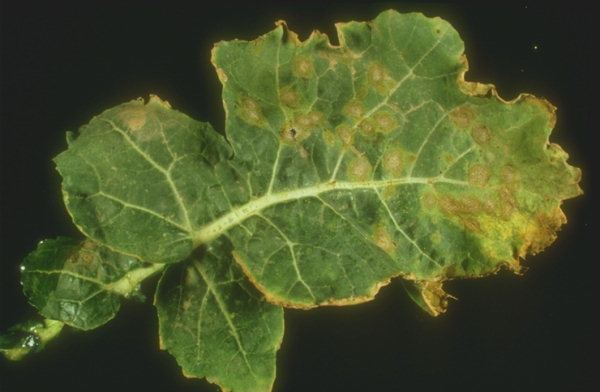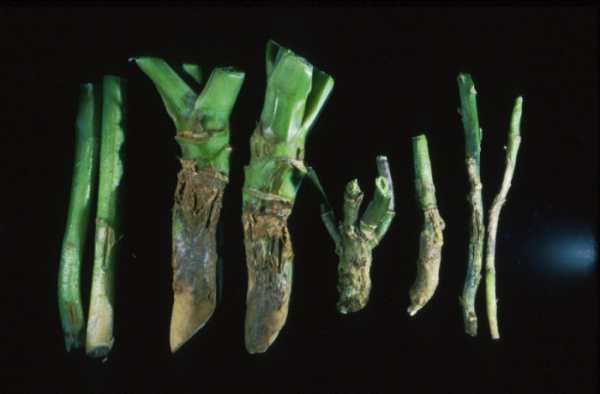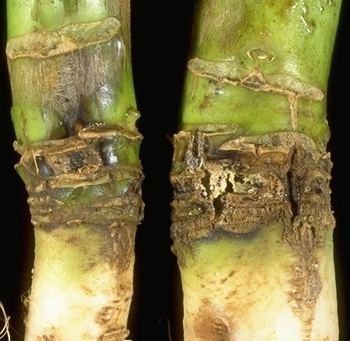Rank Species | Genus Leptosphaeria Higher classification Leptosphaeria | |
 | ||
Similar Leptosphaeria, Phoma, Alternaria brassicae, Sclerotinia sclerotiorum, Sclerotinia | ||
Leptosphaeria maculans (anamorph Phoma lingam) is a fungal pathogen of the phylum Ascomycota that is the causal agent of blackleg disease on Brassica crops. Symptoms of blackleg generally include basal stem cankers, small grey lesions on leaves, and root rot. The major yield loss is due to stem canker. The fungus is dispersed by the wind as ascospores or rain splash in the case of the conidia. L. maculans grows best in wet conditions and a temperature range of 5–20 degrees Celsius. Rotation of crops, removal of stubble, application of fungicide, and crop resistance are all used to manage blackleg. The fungus is an important pathogen of Brassica napus (canola) crops.
Contents

Host and symptoms

L. maculans causes phoma stem canker or blackleg. Symptoms generally include basal stem cankers, small grey oval lesions on the leaf tissue and root rot (as the fungus can directly penetrate roots).L. maculans infects a wide variety of Brassicae crops including cabbage and oilseed rape. L. maculans is especially virulent on Brassica napus. The first dramatic epidemic of L. maculans occurred in Wisconsin on cabbage. The disease is diagnosed by the presence of small black pycnidia which occur on the edge of the leaf lesions. The presence of these pycnidia allow for this disease to be distinguished from Alternaria brassicae, another foliar pathogen with similar lesions, but no pycnidia.
Disease cycle

L. maculans has a complicated life cycle. The pathogen begins as a saprophyte on stem residue and survives in the stubble. It then begins its necrotrophic cycle by producing leaf spots. Colonizing the plant tissue systematically, it begins its endophytic stage. When the growing season ends, the fungus causes cankers beginning another necrotrophic stage.

L. maculans has both a teliomorph phase (ascospores) and an anamorph phase (pycnidia). The disease spreads by wind born dispersal of ascospores and rain splash of conidia. In addition, phoma stem canker can also be spread by infected seeds when the fungus infects the seed pods of Brassica napus during the growing season, but this is far less frequent. The disease is polycyclic in nature even though the conidia are not as virulent as the ascospores. The disease cycle starts with airborne ascospores which are released from the pseudothecia in the spring. The ascospores enter through the stomata to infect the plant. Soon after the infection, gray lesions and black pycnidia form on the leaves.
During the growing season, these pycnidia produce conidia that are dispersed by rain splash. These spores cause a secondary infection which is usually less severe than primary infection with ascospores. Stem cankers form from the disease moving systemically through the plant. Following the colonization of the intercellular spaces, the fungus will reach a vascular strand and spread down the stalk between the leaf and the stem. The disease will spread into as well as between the cells of the xylem. This colonization leads to the invasion and destruction of the stem cortex, which leads to the formation of stem canker.
Stubble forms after the growing season due to residual plant material left in the field after harvest. The disease overwinters as pseudothecia and mycelium in the stubble. In spring the pseudothecia release their ascospores and the cycle repeats itself.
Environment
Temperature and moisture are the two most important environmental conditions for the development of L. maculans spores. A temperature of 5-20 degrees Celsius is the optimal temperature range for pseudothecia to mature. A wet humid environment increases the severity of the disease due to the dispersal of conidia by rain splash. As well as rain, hail storms also increase the severity of the disease.
Management
Cultural methods such as removing stubble and crop rotation can be very effective. By removing the stubble, overwintering pseudothecia and mycelium are less prevalent, reducing the risk of infection. In Canada, crop rotation decreases blackleg dramatically in canola crops. It is suggested to have a 3-year crop rotation of canola and to plant non-host plants such as cereals in between these periods. Chemical methods, such as the application of fungicides, can decrease instances of disease. EBI and MBC fungicides are typically used. EBI fungicides inhibit Ergosterol biosynthesis whereas MBC fungicides disrupt beta tubuline assembly in mitosis. EBIs are the best option for control of L. maculans as they inhibit the growth of conidia. Although fungicides such as EBIs are effective on conidia, they have no effect on ascospores which will grow regardless of the fungicide concentration. Resistance methods can also be used to great effect. Typically race specific Rlm genes are used for resistance (Rlm1-Rlm9) in Brassica napus crops.
Importance
L. maculans is the most important pathogen of Brassica napus, which is used as a feed source for livestock and for its rapeseed oil. L. maculans destroys around 5–20% of canola yields in France. The disease is very important in England as well. From 2000 to 2002, the disease resulted in approximately ₤56 million worth of damage per season. Rapeseed oil is the preferred European oil source for biofuel due to its high yield. Brassica napus produces more oil per land area than other sources like soybeans. Major losses to oilseed crops have also occurred in Australia. The most recent significant losses were in 2003, to the widely-planted B. napus cultivars containing a resistance gene from B. rapa.
L. maculans metabolizes brassinin, an important phytoalexin produced by Brassica species, into indole-3-carboxaldehyde and indole-3-carboxylic acid. Virulent isolates proceed through the (3-indolylmethyl)dithiocarbamate S-oxide intermediate, while avirulent isolates first convert brassinin to N-acetyl-3-indolylmethylamine and 3-indolylmethylamine. Recent research has shown that Brassinin could be important as a chemo-preventative agent in the treatment of cancer. Control of L. maculans is important in order to preserve the vital Brassinin from digestion.
As a bioengineering innovation, in 2010 it was shown that a light-driven protein from L. maculans could be used to mediate, alongside earlier reagents, multi-color silencing of neurons in the mammalian nervous system.
